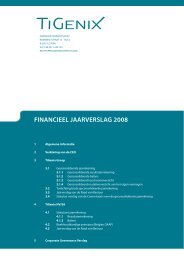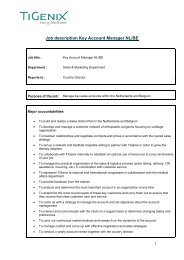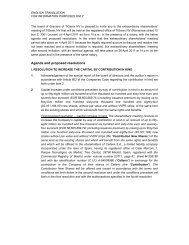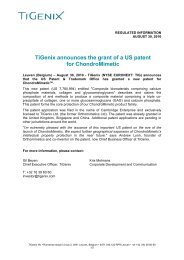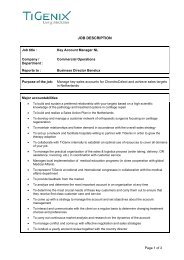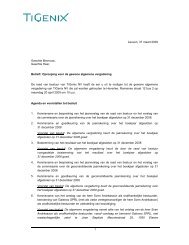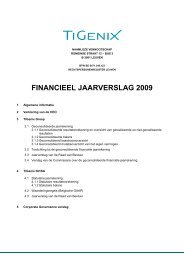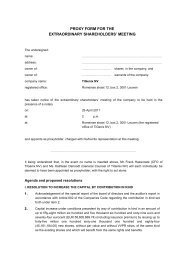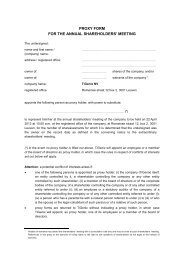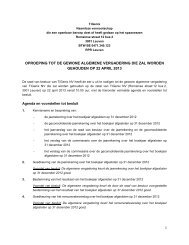ANNUAL REPORT 2012 - TiGenix
ANNUAL REPORT 2012 - TiGenix
ANNUAL REPORT 2012 - TiGenix
Create successful ePaper yourself
Turn your PDF publications into a flip-book with our unique Google optimized e-Paper software.
Different routes of administration of eASCs<br />
Products<br />
The choice of injecting the eASCs through<br />
different routes relies on a combination of the<br />
type of disease and targeting the immune<br />
system in the most optimal way. For local<br />
diseases or tissue damage, depositing the<br />
cells as close as possible to the affected<br />
tissue or organ is expected to optimize<br />
the effect of the cells. Indeed, locally<br />
administered cells will not be diluted, and<br />
thus achieve the highest concentration of<br />
cells at the site of action. Moreover, the cells<br />
will encounter immediately the inflamed<br />
environment leading to direct activation<br />
of the eASCs and their immunomodulatory<br />
actions. Therefore, diseases like fistulas and<br />
IBD are targeted by local administration of<br />
the cells.<br />
For systemic diseases like rheumatoid arthritis<br />
(“RA”), where the cells need to act at several<br />
places in the body, systemic administration<br />
of the cells is the method of choice. Indeed,<br />
systemic administration, either through the<br />
blood or lymphatic circulation, will allow the<br />
cells to be distributed throughout the body<br />
to reach the affected tissues. The capacity of<br />
eASCs to sense inflammation and to migrate<br />
to the site of inflammation is expected to<br />
result in an efficient mechanism of action at<br />
the site of inflammation.<br />
6.5.1.1. Cx601<br />
Cx601 is a suspension of allogeneic eASCs<br />
delivered locally in the fistula through intralesional<br />
injection. Cx601 is being developed<br />
for the treatment of perianal fistulizing<br />
Crohn’s disease.<br />
As set out in more detail in section 6.5.2.1,<br />
Crohn’s disease is a chronic inflammatory<br />
disease of the intestine. It is characterized by<br />
focal or segmental transmural inflammation,<br />
which may occur in any part of the digestive<br />
tract. Crohn’s patients can suffer from<br />
complex perianal fistulas for which today no<br />
efficient treatment exists.<br />
Cx601 received Orphan Drug designation by<br />
the EMA in Q4 2009.<br />
Clinical development<br />
<strong>TiGenix</strong> is developing Cx601 for the treatment<br />
of complex perianal fistula in Crohn’s disease<br />
patients. Cx601 utilizes expanded adult<br />
allogeneic stem cells derived from adipose<br />
tissue, which the Company understands to<br />
have anti-inflammatory properties and be<br />
an effective mechanism for the treatment of<br />
fistulas.<br />
Finally, the intralymphatic route appears to<br />
be very attractive, since it is expected that<br />
the systemic effect of the cells will ultimately<br />
be executed at the secondary lymphoid<br />
organs : draining lymph nodes and spleen.<br />
Recent preclinical and clinical experience<br />
with vaccines 16 and antitumor 17 agents has<br />
demonstrated the feasibility and practical<br />
use of this administration route.<br />
In a Phase II clinical trial, Cx601 showed<br />
efficacy at 24 weeks of 56 % in treated<br />
fistula tracts, which is more than 2 times<br />
higher than the current standard of care<br />
(anti TNF). Efficacy was measured as the<br />
complete closure and re-epithelization of<br />
the fistula being treated with absence of<br />
drainage. Additionally, 69.2 % of patients<br />
had a reduction in the number of initially<br />
draining tracts. The trial also confirmed the<br />
16<br />
Curr Opin Allergy Clin Immunol. 2009 Dec;9(6) :537-43. “Intralymphatic immunotherapy.”Senti G, Johansen P, Kündig TM.<br />
17<br />
Cytotherapy. 2007;9(8) :755-70. Epub 2007 Oct 4.”Phase I study of tumor Ag-loaded IL-12 secreting semi-mature DC for the treatment<br />
of pediatric cancer.” Dohnal AM, Witt V, Hügel H, Holter W, Gadner H, Felzmann T.<br />
61



